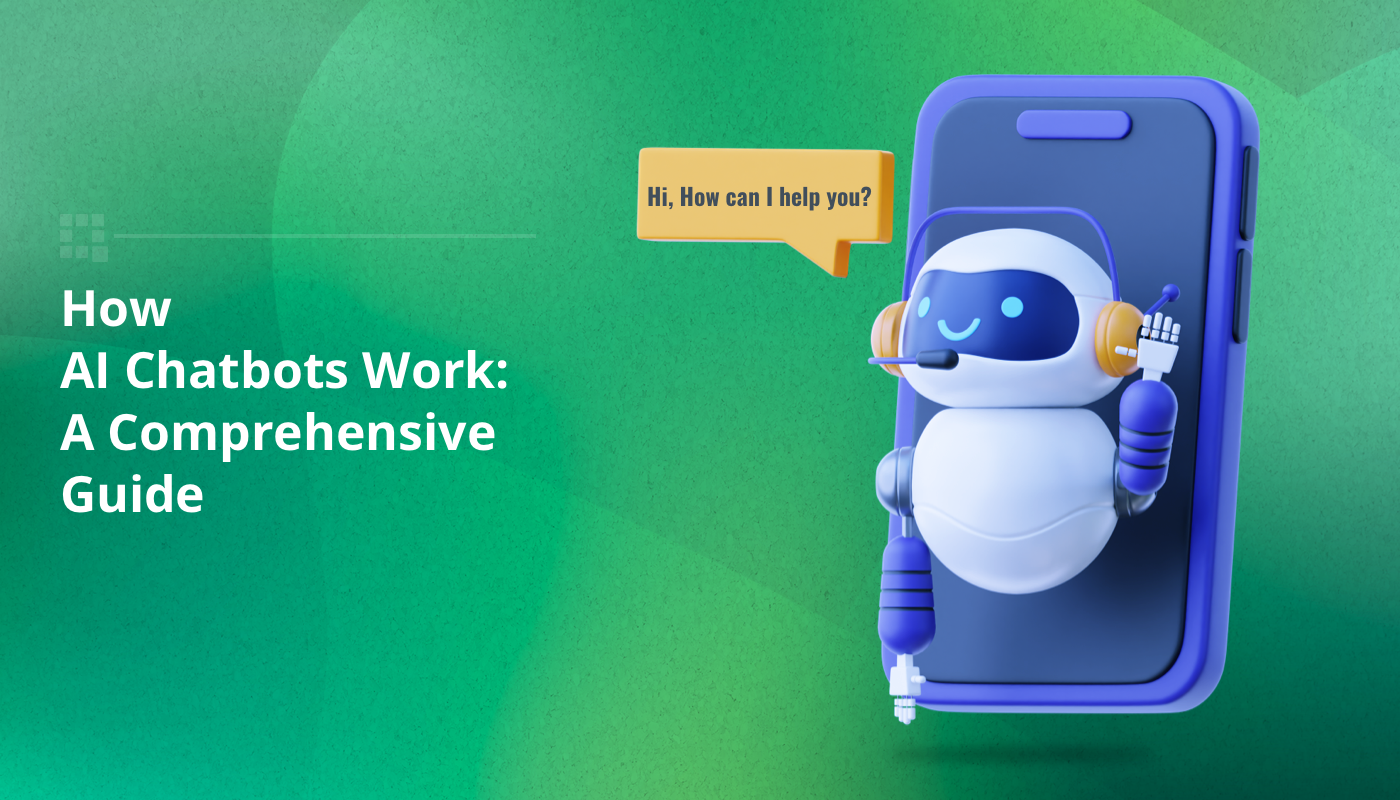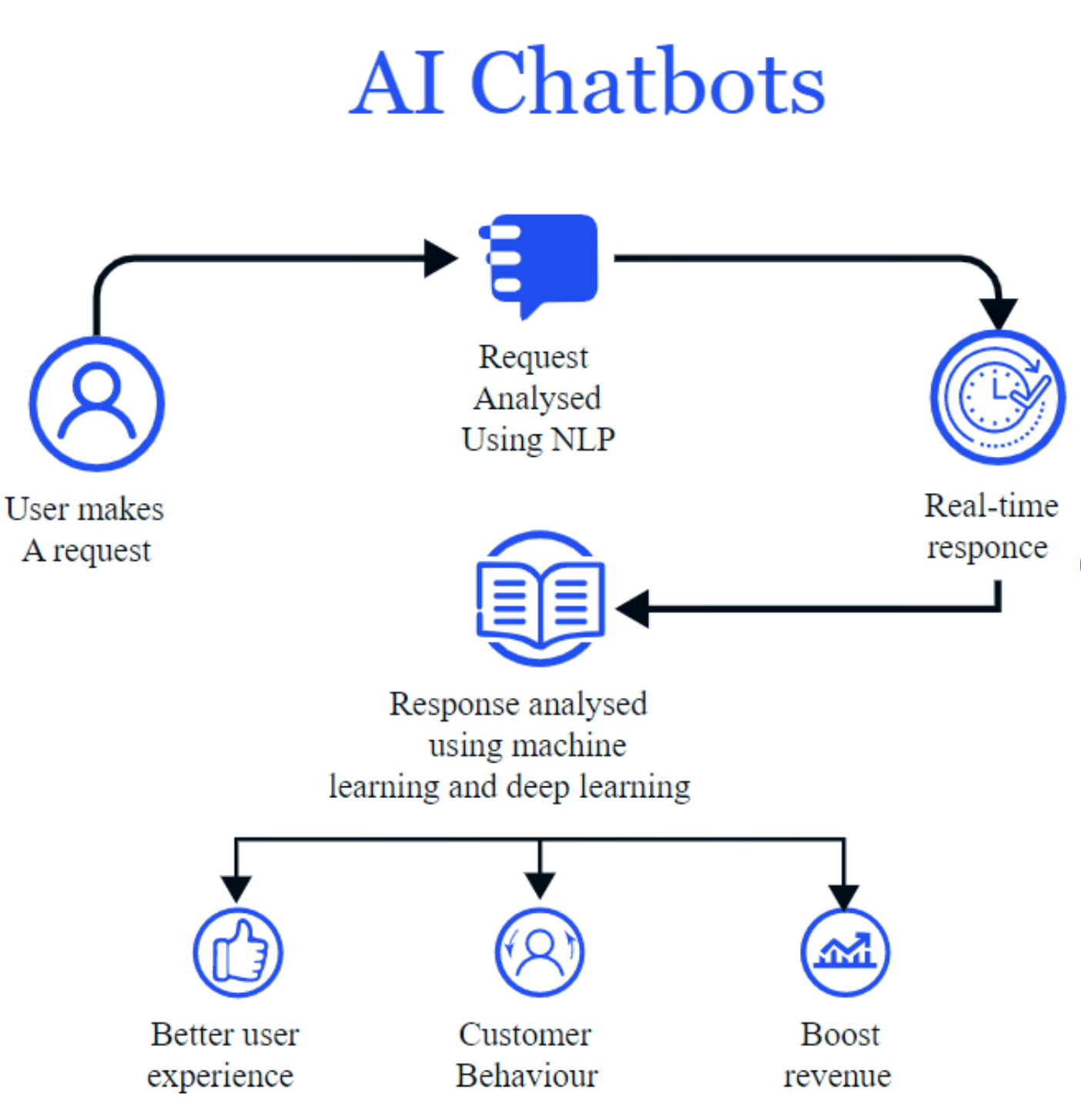
Summary: In this comprehensive guide, we delve into the inner workings of AI chatbots, unraveling the intricate mechanisms that power these virtual entities. We explore the core technologies including natural language processing and machine learning, outline how chatbots learn, and consider future development.
Table of Contents
Introduction
AI chatbots are becoming more and more commonplace, many becoming household names. Most famously ChatGPT is on hand to offer engaging and informative conversations on any number of topics. Replika is the “AI companion that cares.”offering friendship and support to users seeking a listening ear. My AI aims to be a personal companion for Snapchat users, suggesting gifts, planning trips, or answering trivia questions. Woebot, the mental health chatbot, offers personalized cognitive-behavioral therapy techniques, assisting users in managing anxiety, depression, and stress in the comfort of their own devices. And the list goes on.
These examples merely scratch the surface of the vast landscape of AI chatbots that have permeated our daily lives. From virtual assistants guiding us through our routines to healthcare bots offering medical advice, the versatility and utility of chatbots continue to expand and their availability in online platforms and apps improves user experience. These intelligent virtual assistants have become ubiquitous, seamlessly blending into websites, messaging platforms, and customer service channels, reshaping how we interact with technology and each other. But how do AI chatbots work? What makes them capable of engaging in human-like conversations and providing valuable assistance?
This guide explores the inner workings of AI chatbots, uncovering the mechanisms behind their intelligence and the algorithms powering their responses.
Understanding AI Chatbots
Chatbots, short for “chat robots,” are AI-driven software programs designed to simulate human-like conversations with users via text or speech interfaces. These virtual assistants leverage Natural Language Processing (NLP) and Machine Learning (ML) algorithms to understand user queries, generate responses, and execute tasks autonomously.
At their core, chatbots serve as intermediaries between users and computer systems, capable of interpreting human language inputs and providing relevant outputs or actions. They aim to replicate human conversational behavior to facilitate various tasks, such as answering questions, providing recommendations, assisting with transactions, and more.
Learn more about, The Evolution of AI Smart Chatbot Assistants in Customer Service
Core Technologies Behind AI Chatbots
Let’s look at the specifics of NLP and ML in more detail to sharpen our understanding of how AI chatbots work.
Role of Natural Language Processing (NLP)
NLP can be considered the backbone of an AI chatbot’s functionality. It allows chatbots to interpret, understand and converse in human language, providing a smoother interactive experience.
NLP encompasses several steps to extract the meaning from the text provided by the users:
Tokenization: Breaking down text inputs into smaller units, such as words or phrases, to facilitate analysis.
Part-of-Speech (POS) Tagging: Assigning grammatical categories (e.g., nouns, verbs, adjectives) to words in a sentence to understand their roles.
Named Entity Recognition (NER): Identifying and categorizing named entities (e.g., people, organizations, locations) within text.
Semantic Analysis: Understanding the meaning and context of words and phrases to extract actionable insights.
Sentiment Analysis: Determining the emotional tone or sentiment expressed in text inputs.
However, NLP does not stop at understanding and interpretation. It further extends to generating responses that are coherent, contextually relevant, and as human-like as possible. This response generation is a multi-step process that selects the best response from a predefined list or generates one from scratch using ML techniques.
Learn more about, Revolutionize Your Chats with AI: Introducing SmartChat Assistant
Machine Learning and AI Chatbots
ML is a second core technology that enables AI chatbots to function at an advanced level. ML allows AI chatbots to learn from past experiences and user interactions, which in turn refines their response accuracy over time.
When an AI chatbot interacts with a user, it doesn’t just process and analyze the immediate user input. Instead, it compiles and stores data from these conversations, referencing them for future interactions. Thanks to ML, AI chatbots can recognize patterns in human language, understand user intent better, and provide more accurate responses. This capability to self-learn and self-improve is truly the secret sauce behind how AI chatbots work.
Say, for instance, a user expresses dissatisfaction with a service. An AI chatbot, facilitated by ML, can recognize expressions of dissatisfaction over time and understand multiple ways it can be conveyed. Later interactions allow the chatbot to better recognize and respond to similar sentiments, either by addressing the issue or if appropriate, escalating it to a human operator for intervention.
This ability of AI chatbots to learn comes with a critical caveat: the initial learning curve. During the initial stages, the AI chatbot might fall short in providing accurate responses as it’s still learning the ropes. However, over time, after countless interactions, refining and updating the data it processes, its responses will significantly improve.

Image from ResearchGate
There are several ways that chatbots learn:
Supervised Learning: Training models on labeled datasets, where the input-output relationships are known, to make predictions on new data.
Unsupervised Learning: Discovering patterns and structures in unlabeled data without explicit guidance.
Reinforcement Learning: Learning through interaction with an environment to maximize rewards or achieve specific goals.
Deep Learning: Deep Learning (DL) is a subset of ML that utilizes neural network architectures with multiple layers (hence “deep”) to learn complex representations of data. DL models revolutionize chatbots by enabling them to generate context-rich responses, understand context over longer conversations, and exhibit more human-like conversational behavior. Common DL architectures include:
Recurrent Neural Networks (RNNs): Well-suited for sequential data processing, such as language inputs, by maintaining internal state or memory.
Convolutional Neural Networks (CNNs): Primarily used for image processing tasks but can be adapted for text analysis through techniques like text embedding.
Transformers: Introduced breakthroughs in NLP with models like BERT and GPT, capable of capturing long-range dependencies and contextual information.
Learn more about, Choosing the Right Real-Time SmartChat Assistant for Your Business
Training AI ChatBots
Chatbots are only as good as the data source that they’re trained on. Training AI chatbots involves the process of exposing them to data, refining their algorithms, and optimizing their performance to better understand and respond to user inputs.
In the training phase of AI chatbots, developers undertake a meticulous process aimed at equipping the chatbots with the capability to engage in meaningful conversations with users. Here are the key stages involved:
Data Collection and Preprocessing: This process begins with data collection, where developers gather real-world conversational data, which serves as the foundation for training. This data undergoes rigorous preprocessing to clean noise and standardize formats, ensuring optimal learning conditions for the chatbot. Additionally, data augmentation techniques may be employed to enrich the dataset, particularly in cases where the initial dataset is limited.
Annotation and Labeling: Once the data is prepared, it undergoes annotation and labeling, where human annotators assign relevant tags or labels to different parts of the dataset, such as intents, entities, or sentiment labels. This annotated dataset serves as the training ground for the chatbot’s algorithms.
Model Selection and Training: Model selection follows, with developers choosing the appropriate architecture based on the chatbot’s requirements and complexity. This could range from simple rule-based systems to advanced deep learning models. The selected model is then trained on the annotated dataset, fine-tuning parameters and optimizing performance through iterative experimentation.
Evaluation and Validation: Evaluation metrics, including automated measures and human evaluation, are employed to assess the chatbot’s performance before deployment. Continuous monitoring and feedback mechanisms drive iterative refinement, ensuring that the chatbot evolves to meet changing user needs and linguistic patterns over time.
Future Trends in AI Chatbots
The future of AI chatbots holds exciting possibilities as advancements in technology continue to push the boundaries of what is possible.
Advancements in Natural Language Understanding (NLU): Ongoing research and development efforts in NLU are expected to further enhance chatbots’ ability to understand and generate human-like language, enabling more natural and contextually relevant interactions.
Multimodal Chatbots: The integration of voice, text, and visual inputs/output capabilities will enable chatbots to interact with users across multiple modalities, offering a more seamless and intuitive user experience.
Personalization and Context Awareness: AI chatbots will become increasingly adept at understanding user preferences, behaviors, and contexts, allowing for highly personalized interactions tailored to individual users’ needs and preferences.
Advanced Conversational AI: Continued advancements in deep learning techniques, particularly in areas such as generative models and reinforcement learning, will enable chatbots to engage in more sophisticated and natural conversations, exhibiting human-like conversational abilities.
Integration with Augmented Reality (AR) and Virtual Reality (VR): The integration of chatbots with AR and VR technologies will open up new opportunities for immersive and interactive experiences, enabling users to engage with chatbots in virtual environments and real-world contexts.
Ethical and Responsible AI: As AI chatbots become increasingly autonomous and capable of making decisions on behalf of users, there will be a growing emphasis on ethical and responsible AI practices, including bias mitigation, privacy protection, and ensuring accountability in AI-driven interactions.
Conclusion
AI chatbots represent a transformative technology that is reshaping how businesses and individuals interact with digital systems. Through the integration of sophisticated natural language processing and machine learning algorithms, AI chatbots can understand user queries, provide personalized assistance, and streamline workflows across various domains and industries. From customer support and sales to healthcare and education, the potential applications of AI chatbots are vast and diverse.
One such versatile AI chatbot is SmartChat Assistant by QuickBlox. SmartChat Assistant offers the flexibility to be trained on customized datasets, empowering organizations to tailor chatbot responses to their specific needs and preferences. With seamless integration capabilities, SmartChat assistant can be effortlessly integrated into any website or application, providing users with instant access to AI-driven assistance and support. Whether it’s enhancing customer engagement, streamlining internal processes, or delivering personalized services, SmartChat assistant enables organizations to harness the power of AI chatbots to achieve their business objectives effectively and efficiently. Contact us to find out more.
Talk to a sales expert
Learn more about our products and get your questions answered.
Contact sales







